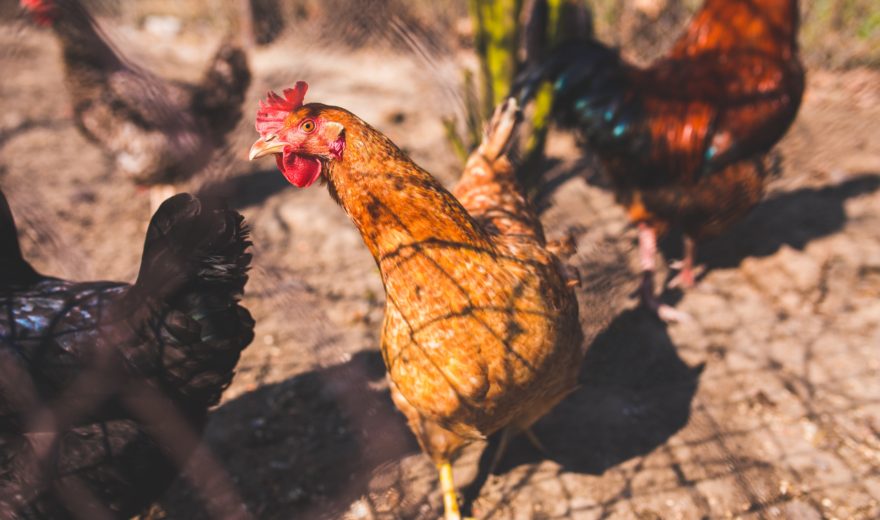
Being a chicken owner means being well-versed in care for your flock. Most tend to be easy keepers, but occasionally (just as we all do) when they get sick or are having issues, we must deal with it. Here are some of the most common health problems you might face with your flock.
#1. Coccidiosis - Coccidiosis causes a considerable economic loss in the poultry industry. Chickens are susceptible to at least 11 species of coccidia.
- How is it spread? – Chickens get coccidiosis by eating oocysts that have been shed in the droppings of infected chickens. Infected chickens shed oocysts for several days or weeks.
- Symptoms – Droopiness and lethargy; decreased appetite; ruffled, unthrifty feathers; huddling or acting chilled; pale skin; diarrhea, dehydration, and in some cases death. In the early stages, there can be blood or mucus in the feces and growth issues.
- Remedy – Use good sanitation practices, keep litter dry, avoiding crowding. Chicks gradually develop resistance and most mature chickens develop immunity.
#2 Fowl Pox - This highly contagious viral infection comes in two forms, dry and wet. Dry is the most common type and is a viral infection.
- How is it spread? – Dry form is typically spread by mosquitoes, mites and ticks or other insect bites. May also be transmitted through open wounds, scabs or feathers. The wet form is transmitted through drinking from the same water as infected birds.
- Symptoms – In the dry form, birds will show small white pimple like bumps, turning into blisters on the comb and wattles. These will turn into large bumps, become hard and fall off creating scabs and eventually scars. Can have fever, loss of appetite, general unwell appearance. In the wet form, wet cheesy looking growths appear in the throat and a thin membrane forms in the mouth and larynx. The wet form is more likely to be fatal and the dry pox is not as serious. The survivors are not carriers.
- Remedy – A vaccine is available in areas where the disease is common or an outbreak occurs. Insect control and mosquito management help to keep occurrence minimal. Controlling dry pox will help to reduce wet pox, which will spread through a flock rather quickly.
#3. Marek’s Disease - It remains the most common yet contagious disease because it affects birds intensely – it is fatal and still untreated. Usually, it affects the younger chickens because of their weak immune systems.
- How is it spread? – It's spread by the loss of feathers and dust.
- Symptoms – Typical symptoms include difficulty breathing, paralyzed neck, wings, & legs
- Cutaneous form – red swollen feather follicles
- Neural form – progressive paralysis, labored breathing, diarrhea, death
- Ocular form- gray oddly shaped iris, blindness and death
- Visceral form – tumors on internal organs
- Remedy – Natural Course of Action – some breeds are resistant, use good sanitation practices and keep the chicks away from the adults until 5 months of age.
#4 Mites - A mite is a blood-feeding parasite. The affected chickens may have blood spots on their eggshells and scabby areas on the body or face.
- How is it spread? – Spreads through an infestation in the environment.
- Symptoms – Scabby areas on the face, vent, or body. Blood spots on the eggshells.
- Remedy – There are a number of products both chemical and natural available for the chickens, but you also must treat their environment. Begin using the products early in the spring to try preventing an infestation outbreak.
#5 Mycoplasma Gallisepticum (Chronic respiratory disease, Infectious sinusitis) -Most often affects adult chickens; this is a contagious disease, comes on slow and will last a long time.
- How is it spread? – Often spread by bringing in new birds for the flock, adding bird that is a carrier to your flock and can be passed in ovo from mother to chicks.
- Symptoms – Mostly a respiratory issue, starting with mucus in the eyes, nasal discharge with no odor, cough, sneezing and labored breathing. Birds rapidly decline and if they recover will be carriers and may relapse from time to time.
- Remedy – The best prevention is the use of probiotics for immune health and good biosecurity practices.
Veterinary care - Some antibiotics can help reduce symptoms, but survivors are still carriers. Contact your veterinarian for more information.
Sources:
- Damerow, G. (2015). The Chicken Health Handbook (2nd ed.) Pgs. 197, 224, 225, 261, 264, 104, 108
- Merck Veterinary Manual (2016) 2016 Merck Sharp & Dohme Corp., a subsidiary of Merck & Co., Inc., Kenilworth, NJ, USA. https://www.merckvetmanual.com/poultry

 BACK TO MAIN BLOG
BACK TO MAIN BLOG 
Comment